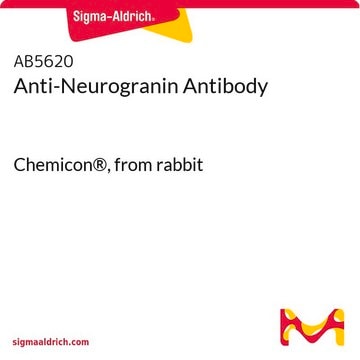추천 제품
생물학적 소스
rabbit
Quality Level
항체 형태
serum
항체 생산 유형
primary antibodies
클론
polyclonal
종 반응성
feline, monkey, human, mouse, rat
제조업체/상표
Chemicon®
기술
immunocytochemistry: suitable
immunohistochemistry: suitable
immunoprecipitation (IP): suitable
western blot: suitable
NCBI 수납 번호
UniProt 수납 번호
배송 상태
dry ice
타겟 번역 후 변형
unmodified
유전자 정보
human ... DPYSL3(1809)
일반 설명
TUC (TOAD [Turned On After Division]/ Ulip/CRMP) is a family of proteins that have emerged as strong candidates for a role in neuronal growth cone signaling. The TUC-4 family members reach their highest expression levels in early post-mitotic neurons during their peak periods of axonal growth. TUC-4 is not expressed in neural progenitors or adult neurons (with minor exception). Data suggests that TUC-4 plays a role in axonal outgrowth, pathfinding and possibly in the process that permits growing axons to choose proper routes and targets (Quinn, 1999). The TUC-4 protein is expressed primarily within the cytoplasm of postmitotic neurons as they begin their migration out of the ventricular zone into the developing cortical plate (Minturn, 1995a). TUC-4 is expressed in neuronal cell bodies, neurites, and along the most distal regions of neuronal growth cones, including the lamellipodia and filopodia (Minturn, 1995b). Expression of TUC-4 is observed by day E12 in rats coincident with the expression of the early neuronal marker class III beta-tubulin (Quinn, 1999). TUC-4 expression is rarely observed in neuronal cells expressing the mitotic marker PCNA (Minturn, 1995a). The expression of TUC-4 has been shown to be upregulated in response to NGF in rats (Minturn, 1995b) and in response to retinoic acid in a human neuroblastoma cell line (SMS-KCNR; Gaetano, 1997).
특이성
Specifically recognizes the TUC-4 (Ulip-1/CRMP-4/DRP-3) splice variants, TUC-4a (64 kDa) and the N-terminally extended TUC-4b (75 kDa) (Quinn, 2003). AB5454 has been reported to label early postmitotic neurons in prenatal rat brain. Labeling is observed primarily within the cytoplasm along the most distal regions of neuronal growth cones including lamellipodia and filopodia. The antibody is not reactive with the proteins TUC-1 (Ulip-3/CRMP-1), TUC-2 (Ulip-2/CRMP-2) or TUC-3 (Ulip-4/CRMP-3). It does not label neural progenitors or radial glia.
면역원
Synthetic peptide corresponding to amino acids 499 to 511 of TUC-4a and amino acids 612-624 of TUC-4b (YDGPVFDLTTTPK)
애플리케이션
Anti-TUC-4 Protein Antibody detects level of TUC-4 Protein & has been published & validated for use in IC, IH, IP & WB.
Immunohistochemistry: 1:1,000-1:5,000 using PFA (DAB detection).
Immunocytochemistry: 1:1,000-1:5,000 (DAB detection).
Western blot: 1:2,500-1:25,000 using alkaline phosphatase.
Immunoprecipitation
Optimal working dilutions must be determined by end user.
Immunocytochemistry: 1:1,000-1:5,000 (DAB detection).
Western blot: 1:2,500-1:25,000 using alkaline phosphatase.
Immunoprecipitation
Optimal working dilutions must be determined by end user.
표적 설명
64 & 74 kDa
물리적 형태
Rabbit Serum. Liquid containing 0.2% sodium azide.
분석 메모
Control
POSITIVE CONTROL: Fetal brain/spinal cord tissue. Human neuroblastoma cell line SMS-KCNR or rat PC12 cells.
POSITIVE CONTROL: Fetal brain/spinal cord tissue. Human neuroblastoma cell line SMS-KCNR or rat PC12 cells.
기타 정보
Concentration: Please refer to the Certificate of Analysis for the lot-specific concentration.
법적 정보
CHEMICON is a registered trademark of Merck KGaA, Darmstadt, Germany
Not finding the right product?
Try our 제품 선택기 도구.
Storage Class Code
12 - Non Combustible Liquids
WGK
WGK 1
Flash Point (°F)
Not applicable
Flash Point (°C)
Not applicable
시험 성적서(COA)
제품의 로트/배치 번호를 입력하여 시험 성적서(COA)을 검색하십시오. 로트 및 배치 번호는 제품 라벨에 있는 ‘로트’ 또는 ‘배치’라는 용어 뒤에서 찾을 수 있습니다.
Kunlin Jin et al.
Journal of cerebral blood flow and metabolism : official journal of the International Society of Cerebral Blood Flow and Metabolism, 24(4), 399-408 (2004-04-17)
Heparin-binding epidermal growth factor-like growth factor (HB-EGF) is a hypoxia-inducible, neuroprotective protein that also stimulates proliferation of neuronal precursor cells. Accordingly, HB-EGF may contribute to recovery from cerebral injury through direct neuroprotective effects, by enhancing neurogenesis, or both. When administered
Lori B Bennett et al.
Neuroscience letters, 475(1), 1-6 (2010-03-20)
Production of new neurons throughout adulthood has been well characterized in two brain regions, the subventricular zone (SVZ) of the anterolateral ventricle and the subgranular zone (SGZ) of the hippocampus. The neurons produced from these regions arise from neural stem
Patrick Gelé et al.
Proteome science, 12, 24-24 (2014-06-20)
Lipid lowering agent such as agonists of peroxisome proliferator-activated receptors (PPAR) are suggested as neuroprotective agents and may protect from the sequelae of brain ischemic stroke. Although the demonstration is not clearly established in human, the underlying molecular mechanism may
Yulia Vainshenker et al.
Clinical medicine insights. Case reports, 10, 1179547617732040-1179547617732040 (2017-10-06)
Patient recovering from traumatic vegetative state has suddenly died from cardiac arrest. In-life improvement of consciousness appeared after reduction of generalized spasticity due to botulinum toxin administration. Neuropathologic examination revealed Musashi1+, Nestin+, PCNA+, and Ki67+ cells in the hippocampus, frontal
Keiichi Yazawa et al.
Translational oncology, 13(3), 100746-100746 (2020-02-28)
Pancreatic intraepithelial neoplasia (PanIN), the most common premalignant lesion of the pancreas, is a histologically well-defined precursor to invasive pancreatic ductal adenocarcinoma (PDAC). However, the molecular mechanisms underlying the progression of PanINs have not been fully elucidated. Previously, we demonstrated
자사의 과학자팀은 생명 과학, 재료 과학, 화학 합성, 크로마토그래피, 분석 및 기타 많은 영역을 포함한 모든 과학 분야에 경험이 있습니다..
고객지원팀으로 연락바랍니다.







